AMD Athlon 64 4000+ & FX-55: A Thorough Investigation
by Anand Lal Shimpi on October 19, 2004 1:04 AM EST- Posted in
- CPUs
Microsoft Office XP SP-2
Here we see in that the purest of office application tests, performance doesn't vary all too much. The spread of performance here is around 6%, which is nothing terribly significant. While AMD continues to top the charts, Intel is basically on par with them here.
For doing the most basic work in Office, you'll find no real performance difference between a top of the line Intel and AMD machine. Head towards the mid range and you'll still find no real difference in performance, only in price.
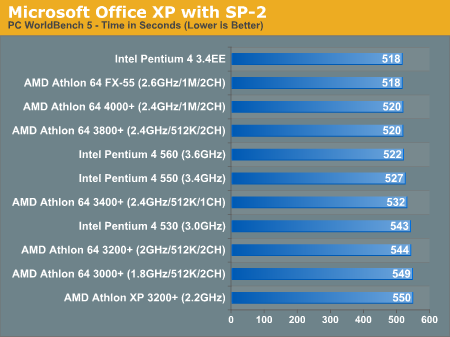
Mozilla 1.4
Quite possibly the most frequently used application on any desktop is the one we pay the least amount of attention to when it comes to performance. While a bit older than the core that is now used in Firefox, performance in Mozilla is worth looking at as many users are switching from IE to a much more capable browser on the PC - Firefox.
Here it's no secret that AMD is clearly on top in performance. What's
truly impressive is that the fastest Athlon 64 is able to complete the Mozilla
test in close to half the time of the Pentium 4 550. The performance advantage
the Athlon 64s hold over the Pentium 4s is impressive to say the least.
We continue to see that a dual channel setup gives the Athlon 64 around
a 5% performance boost. What is quite interesting is the 11% performance
improvement
thanks to a 1MB L2 cache that the 4000+ holds over the 3800+. What
this confirms is that the low memory access latencies provided for
by the
on-die memory
controller
of the Athlon 64 is largely responsible for the performance advantage
here. Looking at the 3.4EE we see that its large L3 cache is able to
make up
for the clock speed deficit, giving it the lead over the Pentium 4
560, further
confirming our statements on what matters when it comes to browser
performance.
Low latency memory accesses matter most here and AMD takes the crown. It is worth noting that you are generally going to be limited by the speed of your Internet connection when it comes to browser performance, however it is always nice to have the snappiest browser experience possible.
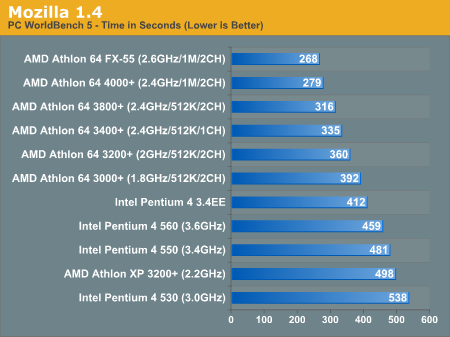
ACD Systems ACDSee PowerPack 5.0
ACDSee is a popular image editing tool that is great for basic image editing options such as batch resizing, rotating, cropping and other such features that are too elementary to justify purchasing something as powerful as Photoshop for. There are no extremely complex filters here, just pure batch image processing.
At 2.4GHz, AMD begins to take the lead from Intel, outperforming even the 3.4EE. The higher up the model number goes, the greater the gap continues to be. There isn't much of a performance difference between the three 2.4GHz chips from AMD, with the biggest difference actually being between the Athlon 64 3800+ and 3400+, or dual vs. single channel memory configurations for those feeling overwhelmed by model numbers. More cache doesn't seem to do much here, as these sorts of operations are largely bandwidth limited and exhibit very little temporal locality with respect to their datasets. We see a 6% gain in performance thanks to the dual channel memory controller of AMD's Socket-939 parts, which is about in line with what we've seen across the board.
The Pentium 4 530 does quite abysmally here, falling behind even the older Athlon XP 3200+. The rest of the Prescott line does appear to do much more reasonably, although at much higher prices than better performing AMD chips.

Ahead Software Nero Express 6.0.0.3
While it was a major issue in the past, these days buffer underrun errors while burning a CD or DVD are few and far between thanks to high performance CPUs as well as vastly improved optical drives. When you take the optical drive out of the equation, how do these CPU's stack up with burning performance?
As you'd guess, they're all pretty much the same, with the slight variations between chips falling within expectations. Any of these chips will do just fine.
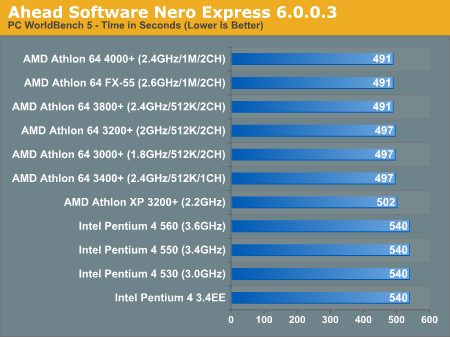
Winzip
Archiving performance ends up being fairly CPU bound as well as I/O limited. Here we continue to see AMD at the top of the charts, closely followed by the high end Intel chips. There's still a 5% performance difference between the single and dual channel 2.4GHz Athlon 64s, which we've been seeing over and over again. We don't see much of a performance boost with the 1MB cache of the 4000+, but the FX-55 does manage to slightly differentiate itself with its higher operating clock.
The Athlon XP does surprisingly well in this test, holding its own against the lower end Athlon 64s.
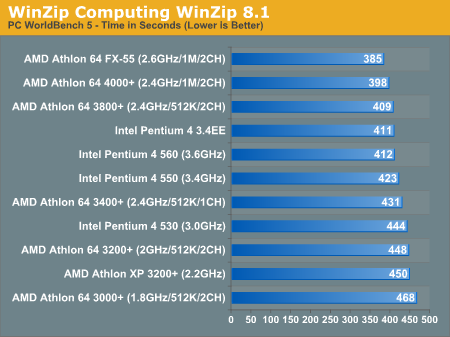
WinRAR 3.40
Pulling the hard disk out of the equation we can get a much better idea of which processors are truly best suited for file compression. While the hard drive hid a lot of the shortcomings of the Athlon XP in WorldBench's WinZip test, they are all revealed in WinRAR's built in benchmark that is largely disk I/O independent.
Here the Athlon 64s show a huge advantage over the Pentium 4 processors, with the slowest Athlon 64 outperforming the fastest Pentium 4 Extreme Edition. The real world performance implications are somewhere in between what we've shown with WorldBench 5's WinZip test and the built-in WinRAR benchmark, needless to say the victor continues to be AMD's Athlon 64.
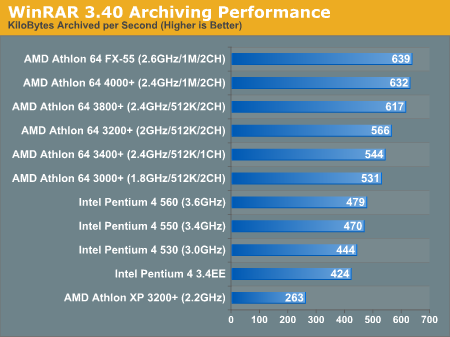










89 Comments
View All Comments
RaistlinZ - Tuesday, October 19, 2004 - link
I may have missed it, but does anyone know if the Athlon 64 4000+ will be multiplier unlocked like the FX-53 is? That's the only thing I see that would differentiate the two chips.RaistlinZ - Tuesday, October 19, 2004 - link
Illissius - Tuesday, October 19, 2004 - link
Re: the necessity of Prescott. You are missing one very important consideration: Prescott has iAMD64 support. (Although it is currently disabled, no doubt because Intel has intentions of selling you the same processor twice). A simple die shrink of Northwood would not.I half suspect one of the reasons for Prescott's problems could be that AMD's 64-bit extensions don't mesh very well with a Netburst architecure, but they had to shoehorn it in anyways, and had to make a lot of unappealing design decisions in the process. (I've never designed a processor, though, so this is just baseless speculation.) I'd be interested in seeing 64-bit enabled chips on a Pentium M architecture...
CrystalBay - Tuesday, October 19, 2004 - link
Moores law is dead...:(Runamile - Tuesday, October 19, 2004 - link
Awsome read. Great Job. And HOLY COW does Intel get their a$$ handed to them!I would of liked to see some price/performance curves too. That would of summed it up quite nicely.
hertz9753 - Tuesday, October 19, 2004 - link
Athlon 64 3700+ 2.4GHz 1MB 64-bitAthlon 64 3400+ 2.4GHz 512KB 64-bit
Athlon 64 3400+ 2.2GHz 1MB 64-bit
araczynski - Tuesday, October 19, 2004 - link
nice, but luckily i still see no reason to upgrade my 2.4@3.3, at least not for a few measly benchmark FPS.hertz9753 - Tuesday, October 19, 2004 - link
AlphaFox - Tuesday, October 19, 2004 - link
Id like to see some kind of comparison with an OC XP Mobile. I have one runing at 2.46ghz and not really sure how it stacks up here...PrinceGaz - Tuesday, October 19, 2004 - link
An excellent article, well done.About the only thing missing was a bit of overclocking of the FX-55 to see if the introduction of strained silicon considerably increased the headroom. Obviously it has allowed them to ship parts rated at 2.6GHz which they weren't previously able to do, but how much better is the FX-55 compared to a CG-stepping FX-53? Does the use of strained silicon mean the FX-55 is a new stepping?